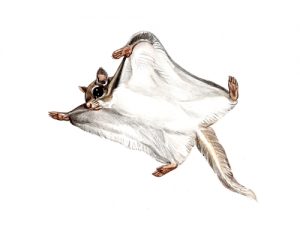Flying Squirrels Will Den in Attics During the Winter
By Chris Williams on February 22, 2012.
Q. What can you tell me about flying squirrels? I think that might be what we have in our attic this winter. We hear them up there just about every night. How do we get rid of them?
A. Flying squirrels are cute little guys, big dark eyes, white belly, and they fit in the palm of your hand. When they’re sitting still, you almost don’t notice the fur-covered sheet of skin that stretches between their front and back toes on each side. These are the wings that they use to fly; actually glide is more like it. They can’t take off from the ground but they can glide, usually 20 to 60 feet, from a high point like a tree trunk…or from your attic.
 Flying squirrels typically nest in hollow trees, old woodpecker holes, or they will build large leaf nests in trees. They are very social, often nesting together. Their tendency to den together is even more pronounced in winter when they are most likely to take up residence in homes in attics or wall voids, entering through small openings around the roof line. They don’t hibernate in the winter, but they do slow their metabolic rate and will curl up together to stay warm during very cold spells. They even grow tufts of hair on their ears and on the soles of their feet during the winter to help keep them warm. These little squirrels are more active during the winter when they’re denning in an attic than if they were in a hollow tree den outside. Most of their foraging is limited to dusk and dawn in cold months, as opposed to all night long in summer.
Flying squirrels typically nest in hollow trees, old woodpecker holes, or they will build large leaf nests in trees. They are very social, often nesting together. Their tendency to den together is even more pronounced in winter when they are most likely to take up residence in homes in attics or wall voids, entering through small openings around the roof line. They don’t hibernate in the winter, but they do slow their metabolic rate and will curl up together to stay warm during very cold spells. They even grow tufts of hair on their ears and on the soles of their feet during the winter to help keep them warm. These little squirrels are more active during the winter when they’re denning in an attic than if they were in a hollow tree den outside. Most of their foraging is limited to dusk and dawn in cold months, as opposed to all night long in summer.
We don’t actually see flying squirrels very often, although there are plenty of them around, because they are nocturnal and arboreal, meaning that they spend their time in trees, not on the ground. They feed on nuts, seeds, insects, birds’ eggs and sometimes nestlings, fungi, and tender tree parts like buds. Females usually have one litter of 3 to 5 young in March to April. There may be a second litter in late summer. Young are weaned in 6 to 8 weeks but stay with mom for several weeks. They learn to glide at about 3 months. We have both the northern and the southern flying squirrels in our region.
The average winter den in our area usually contains about 6 flying squirrels, but there may be many more. In the middle of the night, six squirrels in your attic can sound like a small army. If you have flying squirrels in your attic, you may find food caches of nuts, seeds, pine cones, even the remains of dead mice up there, mixed in with their nest material. They also tend to use a communal toilet area which means you may see brown stains in the attic or running down your siding. Flying squirrels are not dangerous and pose no health hazard. They’re not aggressive but they do have sharp teeth.
Flying squirrels that are denning in homes usually leave in the spring and may return in the fall. Flying squirrels move their dens frequently and sometimes end up in attics for short periods during the summer, as well. If you have flying squirrels denning in your attic or wall voids, call a pest control professional that is licensed and trained in nuisance wildlife work. At Colonial, our experts can exclude flying squirrels from your home with one-way devices, or we can humanely trap and relocate them. We will also squirrel-proof your home, sealing openings that the squirrels use to get inside. Our exclusion work is permanent and guaranteed.